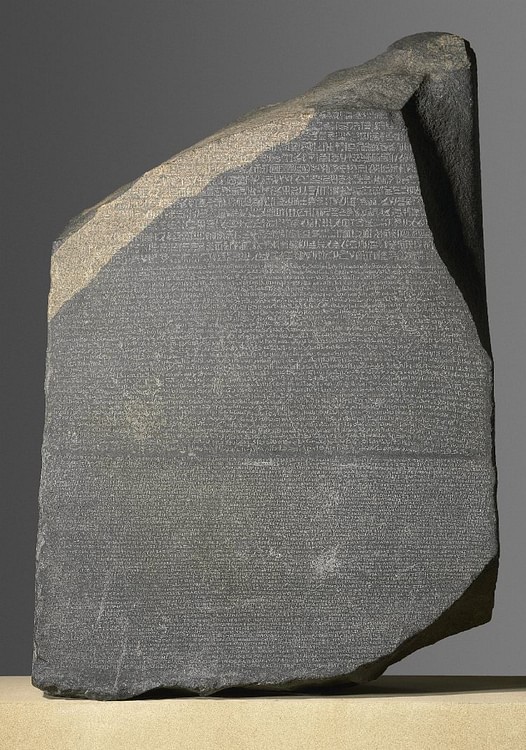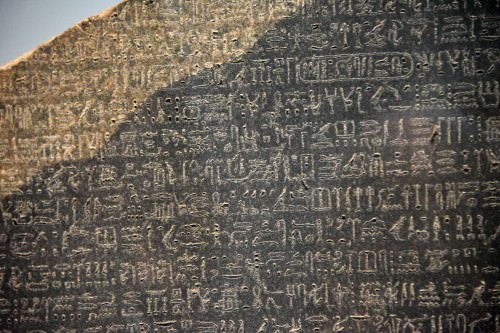Rosetta Stone › Sabratha » Ancient origins
Articles and Definitions › Contents
- Rosetta Stone › Antique Origins
- Sabratha › Ancient History
Ancient civilizations › Historical and archaeological sites
Rosetta Stone › Antique Origins
Definition and Origins

The Rosetta Stone is an incomplete grey and pink granodiorite stela dating from 196 BCE which presents a priestly decree concerning King Ptolemy V of Egypt. The text is in three different versions: Hieroglyphic, Demotic and Greek, a fact which immeasurably helped to finally decipher Egyptian hieroglyphics.
RECOVERY
The stone was discovered at Port Saint Julien, el-Rashid (Rosetta) on the Nile Delta in Egypt in 1799 CE by Pierre François Xavier Bouchard. Bouchard was an officer of engineers in Napoleon's army, and he extracted the stone from an old wall which was being demolished as part of the construction work on Fort Julien. Bouchard's commanding officer, one General Menou, realising its importance, had the stone sent to Alexandria. Casts and copies were made, but the stone was later seized by the British general Tomkins Turner and so the artefact eventually found a permanent home in the British Museum in London.
Several noted international scholars endeavoured to use the stone to decipher hieroglyphics, but it was the Englishman Thomas Young who first identified some of the hieroglyphs which related to Ptolemy V Epiphanes (205-180 BCE) and the direction in which the symbols should be read. However, it was in the early 1820s CE that the text was fully deciphered by Frenchman Jean-François Champollion who discovered that the hieroglyphics were in fact a mixture of alphabetic, determinative and syllabic elements. Consequently, the full significance of Egyptian hieroglyphs, lost for 1600 years, was finally re-discovered.
THE TEXT ON THE STONE IS COMPOSED OF A HIEROGLYPHIC TEXT OF 14 LINES, A DEMOTIC TEXT OF 32 LINES AND A GREEK TEXT OF 54 LINES.
PROPERTIES
The stone measures 112.3 by 75.7 cm and is 28.4 cm thick. The text on the stone is composed of a hieroglyphic text of 14 lines, a demotic text of 32 lines and a Greek text of 54 lines. As portions of the stela are missing - especially the two top corners and bottom right corner - none of the texts are complete. Hieroglyphs was the language of Egyptian priests, demotic script was the commonly used language and Greek was used for administrative purposes. The text of all three writingsystems refers to a decree passed by a priestly council of Memphis which affirms the royal cult of King Ptolemy V of Egypt, one year after his coronation.

Rosetta Stone Detail, Hieroglyphic Text
THE TEXT
The text of the stone begins with a lengthy praise of the achievements and good rule of Ptolemy V. We are told the king has brought great prosperity to Egypt and he has invested large sums of money on temples, both building new ones and restoring old ones, and he has provided grain for the people. Taxes have been reduced or eliminated, and many prisoners who were previously considered enemies of the state have been released during his reign. The king has also quashed Egypt's enemies, and a specific campaign against an enemy fortress is mentioned, the fall of which was due to canals being dammed to block the city 's water supply. To honour all of these deeds, a statue of the king wearing ten gold diadems is to be set up in all temples titled 'Ptolemy Defender of Egypt' and attended to by priests three times a day. He is recognised as the god Ptolemy Epiphanes Eucharistos and as beloved of Ptah. The king's birthday and coronation date are to be celebrated as festivals with libations, sacrifices and feasting, and, likewise, each last day and 17th day of each month are to be days of celebration in honour of the great ruler, beloved by the gods, Ptolemy V. The text concludes by stating that these decrees should be written in stone in three texts - sacred, document and Greek writing - and the stones set up in all temples by the side of the statue of this great king who will live for all time.
Sabratha › Ancient History
Definition and Origins
Sabratha was an ancient Carthaginian city on the coast of north Africa. The name of this city comes from its Punic name SBRTN, of which the pronunciation is still unknown. Sabratha was a major city of Tripolitania, together with Lepcis Magna and Oea.
Archaeological evidence suggests the existence of Sabratha during the 5th century BCE. At this time, it was a seasonal colony of the Carthaginian empire. Despite the area not being fertile, the location was chosen because of a little natural harbor that was ideal for Mediterranean trade. One century later, it became a proper town and the first stone monuments were built. The Carthaginian market that was constructed later became a Roman forum. From this period, archaeologists also found a Tophet(a children's cemetery) and several steles of the Tanit cult. In the south of the city, a necropolis was found that is home to a triangular mausoleum that contains elements of Alexandrian influence and Punic art. The city's most important temples were dedicated to Liber Pater, Isis and Serapis. Very few Punic inscriptions have been discovered in this city.
Archaeological evidence suggests the existence of Sabratha during the 5th century BCE. At this time, it was a seasonal colony of the Carthaginian empire. Despite the area not being fertile, the location was chosen because of a little natural harbor that was ideal for Mediterranean trade. One century later, it became a proper town and the first stone monuments were built. The Carthaginian market that was constructed later became a Roman forum. From this period, archaeologists also found a Tophet(a children's cemetery) and several steles of the Tanit cult. In the south of the city, a necropolis was found that is home to a triangular mausoleum that contains elements of Alexandrian influence and Punic art. The city's most important temples were dedicated to Liber Pater, Isis and Serapis. Very few Punic inscriptions have been discovered in this city.
AFTER THE FALL OF CARTHAGE, THE CITY PROSPERED, AS ITS HARBOR BECAME A TRADE HUB.
After the fall of Carthage, the city prospered, as its harbor became a trade hub. The heyday of the city was during the Antonine period, and it became a Roman colony during the reign of Marcus Aurelius, around 165-166 CE. In 253 CE, the city is mentioned as a bishopric.
Starting in 365 CE, Sabratha slowly declined in importance due to barbarian raids and an earthquake. The last restoration of buildings was in the first part of the 5th century CE in the forum basilica. Vandals and Byzantines also occupied the city.During Justinian's reign, many churches were constructed, the most famous being the basilica mentioned by Procope of Cesarea. The end of Sabratha came with the Arabs, probably around 8th century CE, who used Tripoli as their trade hub.
Starting in 365 CE, Sabratha slowly declined in importance due to barbarian raids and an earthquake. The last restoration of buildings was in the first part of the 5th century CE in the forum basilica. Vandals and Byzantines also occupied the city.During Justinian's reign, many churches were constructed, the most famous being the basilica mentioned by Procope of Cesarea. The end of Sabratha came with the Arabs, probably around 8th century CE, who used Tripoli as their trade hub.
LICENSE:
Article based on information obtained from these sources:with permission from the Website Ancient History Encyclopedia
Content is available under License Creative Commons: Attribution-NonCommercial-ShareAlike 3.0 Unported. CC-BY-NC-SA License